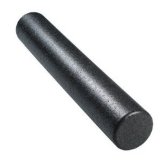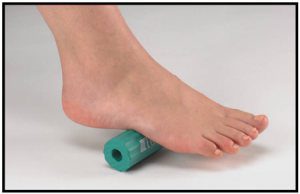Heel Stretching and Strengthening for Patients with Plantar Fasciitis
Plantar fasciitis is one of the most common causes of heel pain and a common complaint of many patients we treat patients at the Foot and Ankle Center.
When we design a treatment plan for your plantar fasciitis, we always look to find the least invasive solution that offers the most effective results and significant pain relief. Some treatment plan options we may consider for your heel pain include stretching exercises, kinesiology taping and night splints. For a complete treatment plan for your plantar fasciitis contact us today for an appointment.
The following treatments should be used in addition to using prefabricated or custom orthotics to reduce tension on the plantar fascia.
Exercises, Stretching and Support for Plantar Fasciitis
Stretching and rolling exercises are important therapies in treating plantar fasciitis. These can be complemented by kinesiology taping and night splints to offer more complete relief for your condition. Based on current research and your individual considerations, we may recommend one or more of the following:
- Stretching exercise – Direct stretch of the plantar fascia
- Rolling exercise – Foam rolling of the back of the calf
- Rolling exercise – Arch of foot roller
- Strengthening exercise to stimulate healing
- Continuous stretch – Using a night splint
- Continuous support – Using kinesiology tape
- High load strengthening – Strengthening exercises to stimulate healing
(1) Stretching Exercise: Direct Stretch of the Plantar Fascia
Studies have shown that a this stretching technique is the most successful form of stretching for plantar fasciitis. It has been shown to be very effective when combined with orthotics and anti-inflammatory therapies and can help to reduce pain significantly.
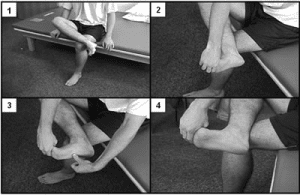
This new stretch targets the plantar fascia more effectively than the standard stretch that was long used – the standing Achilles tendon stretch. We recommend this stretch be performed before taking the first step in the morning and again after prolonged sitting so that it’s done at least three times per day.
To Perform the direct Plantar Fasciitis Stretch:
- Cross one leg over the other
- Hold the base of toes of the affected foot
- Gently pull the toes back towards the shin until you feel a stretch in the arch
- Hold the stretch for 10 seconds and slowly release
- Repeat 10 times
- Perform three sets of 10 repetitions daily
 (2) Rolling Exercise: Foam Rolling of the Calf
(2) Rolling Exercise: Foam Rolling of the Calf
Foam rolling of the calf should be performed daily by plantar fasciitis sufferers to relieve tension on the Achilles tendon (a tight Achilles will increase tension on the plantar fascia). The video below demonstrates how to properly use a foam roller for the calf. The OPTP 6″ x 36″ foam roller is the one we recommend and you can get it here.
Video: How to Foam Roll the Calf
 (3) Rolling Exercise: Arch of Foot Roller
(3) Rolling Exercise: Arch of Foot Roller
You should also spend five minutes per day using a roller on the arch of your foot being sure to push your foot hard into the roller. You can use a frozen water bottle or this Theraband Foot Roller.
(4) Eccentric Strengthening can Help Stimulate Healing of the Plantar Fascia
A 2014 study by Ratcliff demonstrated that doing eccentric training has potential to improve plantar fasciitis symptoms faster than stretching. This is so far the only study on high load training for plantar fasciitis but it is certainly worth considering as another treatment option. You can learn about eccentric strengthening here.
(5) Continuous stretch: Using a night splint
Several studies have shown that night splints might be beneficial in helping to treat plantar fasciitis and Achilles tendonitis. Although they have not been shown to be effective if used as the only treatment for heel pain, they seem to work well in conjunction with other therapies.
By maintaining a gentle stretch on your foot while you sleep, a night splint can prevent nighttime contraction of the tendon and decrease inflammation that causes morning heel pain.
Night splints are one of the best ways to treat morning heel pain. Although night splints are intended to be worn while sleeping, many of our patients find it difficult to sleep while wearing the splint. As an alternative, you can benefit by wearing a night splint during the day for 30 minute intervals while watching TV, reading or working on your computer to speed healing. Plan on using the night splint for the first three to four weeks of treatment.
If both feet hurt, we suggest you initially purchase only one night splint. Even patients that can sleep with one night splint on find it a challenge to sleep wearing two. Those that are back or side sleepers may be more comfortable sleeping while wearing night splints while those that sleep on their stomachs tend to find them less comfortable.
Choosing a night splint – our recommendations
We have reviewed a number of night splints and the following are the ones that we find are most effective, comfortable and affordable (all run around $40). One goes on the bottom of the foot, one on top and the other is a sock. Which one is best for you is a matter of personal preference. If you are not sure, go with the Dorsal Night Splint. Most people find this the most comfortable. Many people find that the sock pulls their toes back into an uncomfortable position.
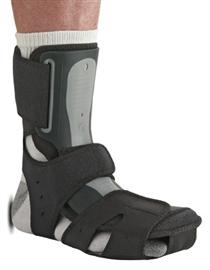 |
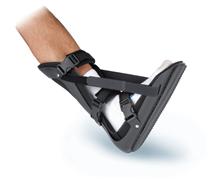 |
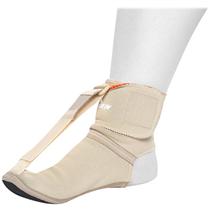 |
| Dorsal Night Splint | Plantar Night Splint | Night Splint Sock |
| (top of foot) | (bottom of foot) |
(6) Continuous support: Using kinesiology tape
Kinesiology tape is a thin, stretchable medical tape that is used to treat a number of foot, ankle and leg injuries. It is similar to human skin in elasticity and thickness. Compared to standard sports tape, it is less irritating to the skin and doesn’t overly constrict movement or feel too tight. Old style athletic tape is wrapped tightly around an injured body part to rigidly support and restrict movement but cannot be left on for long periods (i.e. more than 12 hours) due to excessive motion restriction and skin irritation.
Video: How to Tape for Plantar Fasciitis
In contrast, because kinesiology tape is very thin and flexible, it can provide dynamic support while still allowing a functional and safe range of motion. It is applied directly on the injured area rather than wrapped completely around an injured body part and can be worn four to five days without removal. Kinesiology tape can be worn while bathing or while exercising.
We recommend Rocktape – here’s why: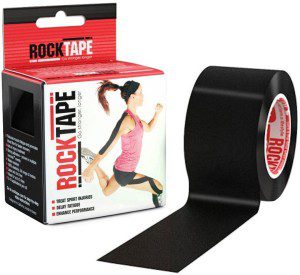
- It has a stronger adhesive than other kinesiology tapes to stay on during intense, prolonged exercise, swimming, showering or bathing.
- It is extra durable due to nylon reinforcement.
- It offers greater elasticity than other kinesiology tapes (190% vs 140%).
- Most applications can be worn up to 5 days.
You can purchase Rocktape here.
References on Stretching and Strengthening for Plantar Fasciitis
BF Digiovanni, et al, “Plantar fascia-specific stretching exercise improves outcomes in patients with chronic plantar fasciitis – A prospective clinical trial with two-year follow-up,” Journal of Bone and Joint Surgery, 88(8), (Aug 2006): 1775-81.
RM Flanigan, et al, “The influence of foot position on stretching of the plantar fascia,” Foot & Ankle International, 28(7), (July 2007): 815-22.
M Powell, “Effective treatment of chronic plantar fasciitis with dorsiflexion night splints: a crossover prospective randomized outcome study,” Foot & Ankle International, 19(1), (Jan 1998): 10-8.
T Beyzadeoğlu, “The effectiveness of dorsiflexion night splint added to conservative treatment for plantar fasciitis,” Acta Orthopaedica et Traumatologica Turcica, 41(3), (2007): 220-4.
Rathleff MS, Mølgaard CM, Fredberg U, et al. “High-load strength training improves outcome in patients with plantar fasciitis: A randomized controlled trial with 12-month follow-up“. Scand J Med Sci Sport 2014
